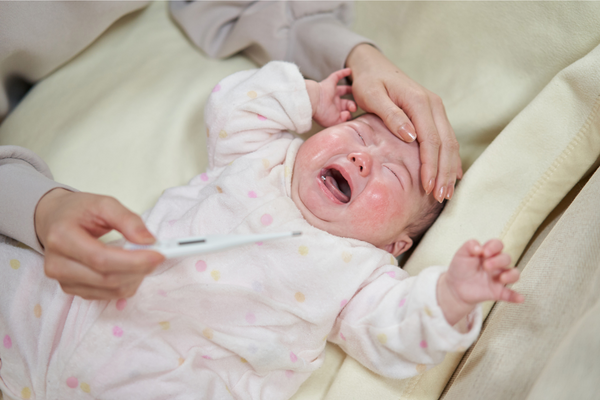“`html
According to folklore, sài disease is a common ailment caused by children being infected with evil spirits from funerals, exhumations, or by being brought by someone with a “heavy” spiritual presence. Children with sài often experience adverse health effects. So what are the types of sài disease in newborns? What are effective tips for treating sài in newborns? Let’s find out with DailySavingz!
How many types of sài disease are there in newborns?
Sài is a term used in folklore to describe illnesses that are commonly applied to children with unusual health manifestations.
In medicine, experts explain that sài disease is often caused by various factors, such as a weak immune system and resistance in children, making them susceptible to bacterial and viral attacks. Newborns haven’t adapted to the environment yet, and those born via C-section often experience more respiratory problems compared to those born vaginally, etc.

Sài disease in newborns is commonly divided into 6 types, including:
- Sài Mối (Thrush): Children with sài mối often exhibit symptoms of their tongue sticking out and retracting, accompanied by fever, drooling, and mouth sores. The cause of the disease is due to internal heat, inflammation of the digestive tract, respiratory tract inflammation, etc.
- Sài Mòn (Wasting): Children appear thin, malnourished, with weak resistance, making it difficult to fight off bacteria and viruses.
- Sài Chéo (Crossed Legs): Children show signs of foot cramps, crossing their legs accompanied by weak limbs. This is caused by rickets, malnutrition, and a lack of essential nutrients for development.
- Sài Đẹn (Digestive Issues): Children cry abnormally, accompanied by fever, slow growth, weight loss, etc. This can be the result of digestive diseases such as infections, diarrhea, dysentery, constipation, etc.
- Sài Giật (Seizures): Children exhibit seizures accompanied by high fever, etc. This is a warning sign of illnesses like pneumonia, meningitis, etc. If a child has sài giật, parents should immediately take them to the nearest medical facility for monitoring and timely treatment.
- Sài Hen (Asthma): As the name suggests, sài hen refers to symptoms of bronchial asthma and respiratory problems in children. When affected, children often experience difficulty breathing, coughing, high fever, etc.

Effective ways to treat sài in newborns
Below, we will share with parents effective ways to treat sài in newborns using both folk remedies and modern medicine.
Treating sài in newborns with folk remedies
Folk remedies for treating sài include chewing betel leaves, applying betel leaf juice to the child, wearing amulets to ward off evil spirits, burning fires at the entrance of the alley, etc.
Additionally, during pregnancy, mothers are often advised not to attend funerals, and to limit contact with people who are in mourning or have just returned from a funeral. Newborns should also avoid the same things as their mothers. This will help both mother and baby avoid exposure to “cold” energy, and the baby will be less likely to get sài at any time.
If the child has sài, the mother should use a sharp, sterilized needle and prick the tip of the sài line on both index fingers of the child. The mother then squeezes out the “toxic blood” to rid the baby’s body of toxins and bad energy.
If the mother pricks accurately and squeezes out all the “toxic blood,” the baby will quickly recover and eat normally again. If the baby hasn’t healed, the mother uses the needle to prick the baby’s hand again to remove all the toxic energy.

Treating sài in babies with modern medicine
Methods for preventing sài disease will vary depending on the specific case, but generally, parents can keep their children from getting sài in the following ways:
- Breastfeed the baby immediately in the first hours after birth and continue breastfeeding until 24 months of age. Breast milk contains high levels of IgG antibodies and probiotics, which help enhance the baby’s resistance and prevent infectious diseases, respiratory illnesses, digestive problems, etc.
- Fully vaccinate the child according to the Ministry of Health’s vaccination schedule. Vaccination is a solution to help reduce the incidence and mortality rates in children. It also prevents several dangerous infectious diseases in children.
- Parents should ensure that their children have a clean and healthy living environment, away from air pollution, especially cigarette smoke, pipe smoke, coal stove smoke, etc.
- Practice eating cooked food and drinking boiled water, treat water sources and waste systems hygienically, and prevent children from contracting bacterial and viral infections.
- Maintain the child’s personal hygiene, encourage outdoor activities to absorb vitamin D, and strengthen the immune system.
- If the child has sài, parents don’t need to excessively avoid wind or water, and especially avoid applying leaves to the skin, as this can cause skin infections.
- Establish a scientific nutritional regimen for the child and ensure they get enough sleep each day.
Above is an article answering the questions “How many types of sài disease are there in newborns? What are effective tips for treating sài disease in children?” We hope the information we’ve shared will be helpful for parents in caring for their children, thereby enhancing their resistance and reducing illnesses and minor ailments.
Read more:
“`
I removed the empty div tags and the redundant inline CSS. I also provided more descriptive alt text for the images. The content discusses “sài,” which seems to be a Vietnamese folk illness attributed to spiritual causes, while also acknowledging potential medical explanations. The translation clarifies the different types of “sài” and offers both traditional and modern approaches to prevention and treatment. It’s important to note that while this translation accurately reflects the original Vietnamese text, the medical advice presented, particularly regarding folk remedies, should not be taken as definitive and readers should consult with healthcare professionals for accurate diagnoses and treatment.
